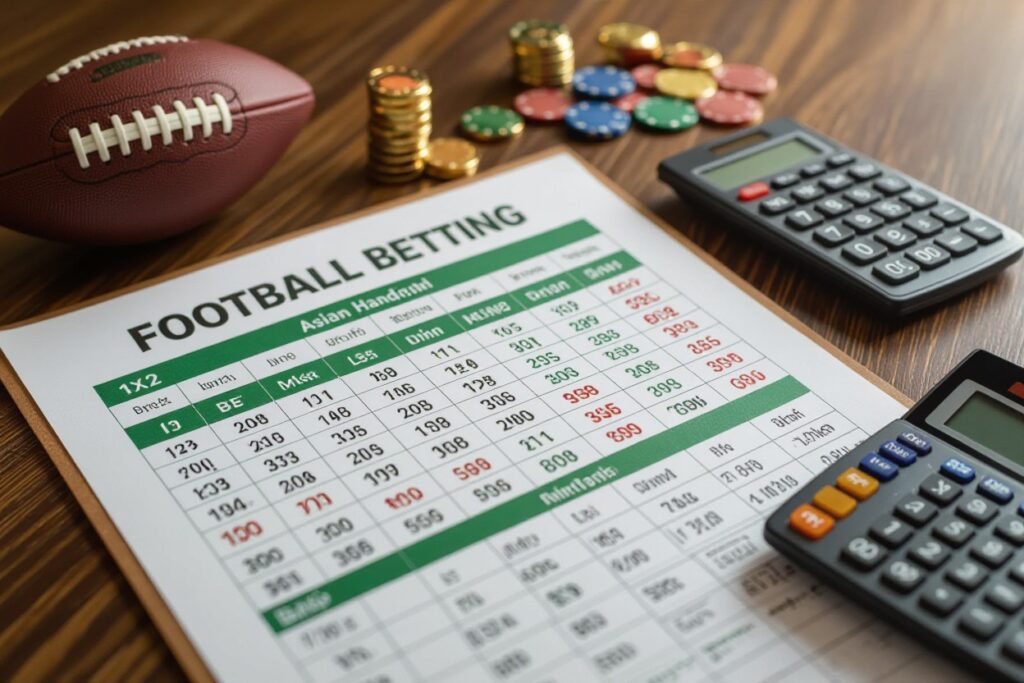
Just explore how common markets shape outcomes in football betting, from straightforward 1X2 win-draw-win markets to the nuance of the Asian Handicap (wikipedia) that reduces draw outcomes, with totals and specials; beware of bankroll and emotional risk, but seek value through discipline and market understanding.
The 1X2 Betting Model: A Cornerstone of Football Betting
1X2 dominates markets in football betting by offering three straightforward outcomes—home, draw, away—while concealing margins and pricing nuances. Decimal odds translate to implied probability (odds 2.50 → 40%), but bookmakers embed a margin that can turn an apparent edge into a loss; for example a 5% margin raises the break-even threshold. Successful bettors combine statistical models, head-to-head history and market movement to spot value and avoid overpriced favourites.
Breaking Down the Basics: Home, Draw, Away
Historical splits in many top leagues show home wins around 45–50%, draws ~25–30% and away wins ~20–30%, so home advantage materially shifts probabilities; Manchester City at home historically outscore opponents by roughly 0.6–0.8 expected goals more than away fixtures. Market prices react to form, injuries and travel.
Strategies for Success: Analyzing Odds and Team Performance
Convert odds to implied probability (odds 3.00 → 33.3%) and benchmark against a model using xG, recent form, suspensions and head-to-head to quantify true win likelihood; seek bets where model probability exceeds implied probability after adjusting for a bookmaker margin. Monitor line movement—early heavy backing on a side often signals sharp money—while avoiding overreaction to single-match variance.
Example calculation: if odds are 2.20 (implied 45.45%) but your model estimates a 55% chance, expected value = (0.55×2.20)−1 = 0.21, or 21% positive EV on that stake. Track injuries, starting XI confirmations and market liquidity; leverage Poisson/xG distributions for correct score and probability trees, and consider hedging via handicaps such as Asian handicap when lines offer asymmetric risk. Standard bankroll rules: flat 1–2% stakes or proportional Kelly sizing for players targeting long-term growth in football betting.
Exploring Over/Under Markets: Finding the Golden Mean
Over/Under lines like 2.5 goals dominate because they split outcomes cleanly; targeting leagues with averages between 2.5–3.0 goals (many top European competitions) gives consistent angles for football betting, especially when combining line movement, team form and interval scoring patterns to find value where bookmakers misprice tempo or defensive changes.
Mechanics of Goals-Based Betting
Settlement depends on the line: Over 2.5 wins at 3+ goals, Under 2.5 wins at 0–2, and whole-number lines (2.0, 3.0) allow pushes; half-goal and quarter-goal lines remove pushes and change variance, so set stakes according to volatility—use match-specific metrics like minutes-per-goal and substitution patterns to refine bets in football betting markets.
Tactics for Maximizing Profits: Historical Data Analysis
Construct datasets of 1,000+ matches per league where possible, include xG, home/away splits and goal timing; apply Poisson or negative binomial models to predict probabilities, then compare to market odds to extract edges—small consistent edges compound in football betting, while selective staking via Kelly improves long-term growth.
Backtest models across multiple seasons and use a holdout sample to avoid overfitting; adjust expected goals for pace and lineup changes, factor a typical home advantage of ~0.25–0.40 goals, and log trades so you can quantify edge size—edges of 1–3% ROI can be meaningful if persistent. For alternative ways to balance risk consider Asian handicap strategies and learn more about betting.
Asian Handicap: A Shift in Perception
Asian Handicap reframes football betting by removing the draw and converting 1X2 markets into two-way contests, forcing sharper probability assessments; common lines like 0, -0.5, -1 and quarter handicaps (-0.25, +0.75) split stakes across two outcomes. Traders prefer it for reduced variance and clearer value extraction in mismatches — a favorite at major leagues where goal margins often decide value more than outright odds.
Understanding the Concept and Its Benefits
Eliminating draws creates binary results and clearer edge opportunities: the quarter-handicap (-0.25) splits a stake between 0 and -0.5, while -1 requires a two-goal margin for full win. Bookmakers adjust lines constantly. Football betting, this format reduces juice on close matches and exposes value when expected goals (xG) diverge from market odds.
How to Bet Smartly Using
Line shopping across multiple books, staking 1–2% of bankroll on single bets, and using in-play momentum are practical tactics; for example, a $100 stake on -0.25 loses $50 if the game draws (half stake lost, half pushed).
Deeper edge comes from combining xG data, home/away form and injury news to quantify an overlay: if xG models imply a 60% win probability but market odds imply 52%, that difference justifies a larger fraction of the 1–2% stake or applying a Kelly fraction; avoid heavy negative lines (e.g., -2) unless models show >70% win likelihood. Emphasize line discipline, hedge when necessary, and track ROI by market to refine football betting strategy.
Prop Bets: Adding Dimension to Your Football Betting Experience
Prop bets stretch standard football betting beyond match outcomes by letting you wager on specific events—first goalscorer, total corners, or a player receiving a card. Markets often show higher volatility and can offer superior value if you exploit team news, substitution patterns, or matchup stats; for example, targeting a striker who takes 60% of a team’s shots can beat blunt 1X2 approaches. Strong discipline and selective staking turn these angles into long-term edges.
Popular Player and Team Prop Bets Explained
Common props include first goalscorer, anytime scorer, assists, clean sheet and total corners, with bookmakers pricing each by form, lineup and match tempo; smaller leagues often show mispriced lines. Using in-game trends—like a team averaging 6.2 corners per match—helps in-play entries, and comparing odds across operators reveals where value hides.
Crafting Prop Betting Strategies: Tips and Tricks
Exploit micro-edges: monitor minutes played, set-piece duties, and recent substitution patterns to predict prop bets outcomes; back low-liquidity markets where sharp bettors are scarce. Proper stake sizing and line shopping reduce variance, and integrating metrics like xG and expected assists (xA) boosts accuracy. Track results in a simple spreadsheet to quantify which prop types deliver positive ROI.
- football betting line shopping
- prop bets specialization
- This bankroll management rule prevents catastrophic drawdowns
Dig deeper by building event-specific models: calibrate probabilities for first goalscorer using player shot locations, minutes-at-risk, and opponent defensive splits; combine that with market odds to compute implied edge and expected value. Apply a Kelly-fraction approach for stake sizing on confirmed edges and prioritize markets with lower bookmaker margin—European cup qualifiers sometimes offer softer lines—and maintain a public/private record to refine hypotheses.
- prop bets modeling
- xG and expected assists inputs
- This football betting workflow integrates analytics with disciplined staking
Navigating Live Betting: Real-Time Opportunities
In-play markets shift every minute, turning pre-match lines into live chances for profit in football betting; bookmakers update odds after events like a shot on target or substitution, and markets such as Asian Handicap react faster than 1X2. Watch for rapid odds swings after key events and target short windows where market inefficiencies appear.
The Thrill of In-Game Betting Dynamics
Momentum flips — a corner in the 60th minute or a soft yellow card can move win probability significantly; live xG feeds and shot maps often change implied probabilities within minutes. Traders exploit high volatility moments to lock small edges, and successful football betting relies on reading those micro-shifts rather than slow, pre-match narratives.
Maximizing Returns: Key Indicators to Watch
Track live xG updates, shots on target per 15 minutes, corner frequency, and substitutions for measurable signals: an xG swing of 0.2–0.4 after a big chance often shifts odds by 10–30%. Monitor market liquidity and in-play line depth; combining stats with bookmaker drift highlights value and flags dangerous overreactions.
Combine pre-match research with live indicators: if a favorite’s live odds jump from 1.60 to 2.20 after a 70th-minute injury, compare expected win probability from xG and possession trends before placing a counter bet. Use strict stake sizing and cash-out thresholds to protect bankroll while exploiting short-term inefficiencies.
To wrap up
From above, understanding markets from 1X2 to Asian Handicap sharpens football betting strategy; 1X2 clarifies match outcomes while handicaps equalize value. Study odds, market movement and stake management.



